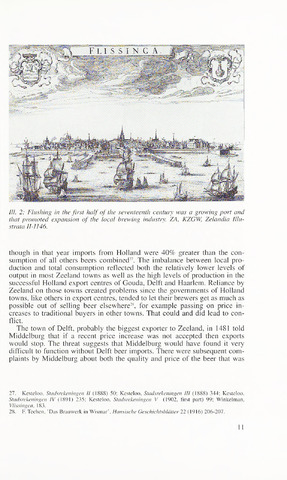III. 2: Flushing in the first half of the seventeenth century was a growing port and
that promoted expansion of the local brewing industry. ZA, KZGW. Zelandia Illu-
strata 11 -I J 46.
though in that year imports from Holland were 40% greater than the con
sumption of all others beers combined27. The imbalance between local pro
duction and total consumption reflected both the relatively lower levels of
output in most Zeeland towns as well as the high levels of production in the
successful Holland export centres of Gouda, Delft and Haarlem. Reliance by
Zeeland on those towns created problems since the governments of Holland
towns, like others in export centres, tended to let their brewers get as much as
possible out of selling beer elsewhere28, for example passing on price in
creases to traditional buyers in other towns. That could and did lead to con
flict.
The town of Delft, probably the biggest exporter to Zeeland, in 1481 told
Middelburg that if a recent price increase was not accepted then exports
would stop. The threat suggests that Middelburg would have found it very
difficult to function without Delft beer imports. There were subsequent com
plaints by Middelburg about both the quality and price of the beer that was
27. Kesteloo. Stadsrekeningen tt (1S88) 50: Kesteloo, Stadsrekeningen III (1888) 344; Kesteloo.
Stadsrekeningen IV (1891) 235; Kesteloo, Stadsrekeningen V (1902. first part) 99; Winkelman,
Vlissingen. 183.
28. F. Tcchcn. 'Das Brauwcrk in Wismar". Hansische Geschichtsblciner 22 (1916) 206-207.
11

